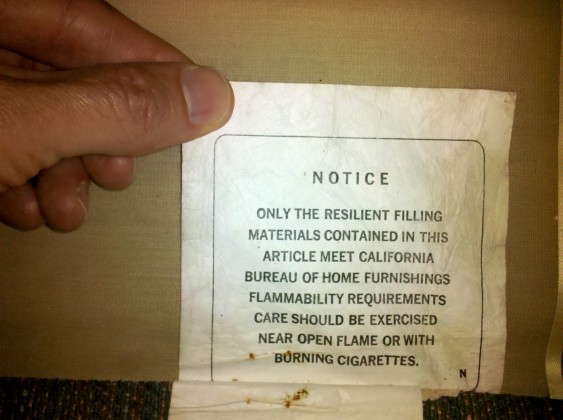Author's note: This blog post originally appeared on Sightline Daily in a series on low-hanging regulatory reform to encourage sustainable practices.
The test is simple: 12 seconds exposed to a small flame like a cigarette lighter. If the furniture foam doesn’t burn, it passes the test and can be sold. If it burns, it fails and cannot. That’s been California’s trial by fire for furnishings—its “flammability standard”—since 1975.
It sounds reasonable enough. Unfortunately, though, this obscure rule turns out to cause an inordinate amount of toxic harm to people, the environment, and pets. Worse, it does this harm without providing any benefits. The rule may have made sense in 1975, when fire-safety science was young, but it’s long past its sell-by date. Simply deleting it from the law books in Sacramento would send benefits rippling up the coast to the Northwest and far beyond as well.
The 12-second rule applies to the foam in couch cushions---not the fabric, just the foam. It also governs the foam in other furnishings such as chairs. And it covers foam-padded child-rearing equipment such as crib mattresses, nursing pillows, and strollers.
Because California is the biggest US market, manufacturers tend to treat the 12-second rule as a North American standard. They don’t want different polyurethane foam formulas for different states and provinces, so most of them make everything to pass the 12-second rule. Consequently, if you check under your couch cushions anywhere in Cascadia, you’re likely to find a tag saying that your sofa satisfies the California flammability standard. (That’s what my couch tag says, below.) Even if you do not find a tag,though, you’re still probably sitting on foam manufactured to pass the 12-second rule.
Foam that passes the test is usually about 5 percent flame retardants. Chemicals made with either bromine or chlorine, flame retardants are designed to delay the combustion of polyurethane, so you can escape from a fire. In the seventies, when the 12-second rule was born, a lot of people were dying in fires started by cigarettes that fell onto upholstered furniture, especially when the smokers fell asleep (often, while drinking). The 12-second rule is basically a cigarette lighter test. In the intervening years, of course, per-capita cigarette consumption has fallen by more than 40 percent. What’s more, residential smoke detectors, sprinkler systems in big buildings, and, most recently, fire-safe cigarettes (which burn themselves out quickly if not tended) are required across the Northwest and beyond. Consequently, fire safety has improved remarkably; the US fire death rate fell by two-thirds from 1979 to 2007, according to the Fire Administration of the US Department of Homeland Security. Canadian fire safety has improved even more rapidly.
The 12-second rule, however, has not changed, despite the steady accumulation of science on a bewildering array of dangers posed by chlorine- and bromine-based flame retardants. These substances crumble with the polyurethane into which they’re blended, filtering out of furnishings, and gradually spreading through your living quarters as house dust. There, they become a long-lasting hazard. They harm children especially. Children roll on the floor more than adults, and they put their hands in their mouths more often. California children carry 2 to 10 times more toxic flame retardants (p. 270) in their bodies than do US adults. Their bodies hold 10 to 100 times more than do children in Europe or Mexico.
Flame retardants also endanger pets. Dogs and cats live closer to the floor and its dust, and cats lick it off themselves. US dogs carry body burdens five to ten times higher than American adults, according to this Indiana University study. US cats carry flame retardants at 20 to 100 times the concentrations of adult Americans, according to this study by federal health scientists. (The photos accompanying this post are of some of my friends’ and coworkers’ pets on their foam furniture.)
Later, from our buildings, flame-retardant dust travels outward, touching house cleaners and employees at sewage treatment plants and dumps. They wash into water and float on the breeze. They reach people everywhere. Flame retardants are so commonplace in North America that they are among the main compounds scientists find when they scan our bodies for synthetic and toxic chemicals. Ultimately, they reach a broad swath of living creatures on Earth, from Columbia Basin ospreys to peregrine falcons to migrating salmon to harbor seals. The highest recorded concentrations of one particularly nasty flame retardant called pentaBDE are in sea lions on the California Coast and in the southern resident pods of Orcas in Puget Sound and the Georgia Strait.
The list of flame retardant chemicals is long, and the list of health effects is longer, documented in hundreds of peer-reviewed scientific articles. (Many are summarized in this comprehensive review.) In short form, though, these compounds are neither healthful nor wholesome. To varying degrees, they can make you, your pets, and other living things infertile, impotent, stunted, fat, diabetic, stupid, malformed, sickly, mutated, cancerous, or dead. The causal relationships are complicated, of course, and the nuances and uncertainties would matter a tremendous amount if flame retardants in furniture foam had compensating virtues. We might forgive them their sins, for example, if they kept us from perishing in house fires. In that case, we would need to think hard about tradeoffs. How much toxicity should we accept to avoid death by smoke inhalation?
But the fact is that the 12-second rule is perfectly useless. It fails as a predictor of actual, real-world fire safety. It is scientifically discredited. If fire-safe furniture is what we want, the 12-second rule is simply irrelevant. Actually, it’s worse than irrelevant. Real-world tests of fire safety suggest that upholstering our living spaces with flame retardants does nothing to slow fires but does make fires more lethal to us. It makes a fire’s smoke more poisonous. It also endangers the firefighters who we expect to rescue us. The 12-second rule may have been a reasonable starting place for testing furniture safety 35 years ago, but we know better now.
One of North America’s leading researchers on fire safety is Vytenis Babrauskas, PhD, of Fire Science and Technology, Inc., in Issaquah, Washington. He and three coauthors recently reviewed the scientific literature on the 12-second rule’s fire safety benefits. Do foams that pass the 12-second test---foams with 5 percent chlorine- or bromine-based flame retardants---reduce the severity of fire or slow it? The answer, they write after looking at every relevant paper published, is “clearly No.” Do foams that pass the 12-second test succeed in resisting ignition, in real-world circumstances? Again, after reviewing all the research, they answer “No.”
Part of the reason is that the 12-second test applies a small flame, like a cigarette lighter, directly to foam, but in real life, flame catches on furniture fabric first and spreads quickly. In these circumstances, 5-percent flame retardants in the foam don’t help.
In tests of real-world circumstances, furniture with 5 percent flame retardants burns up just as surely as furniture without retardants. The retardants do not slow down fires, nor keep them from burning as hot, nor prevent ignition, nor do anything else to improve fire safety. In fact, what they do (p. 284) is fill the smoke of furniture fires---the thing that is most likely to kill fire victims---with more soot (because the combustion is less complete) and more toxic substances (such as carbon monoxide, the flame retardants themselves, and the hyper-toxic dioxin-like compounds they can form when burning). Babrauskas and his coauthors underline their conclusion emphatically:
It is important to emphasize that the above findings have not been disputed. There are no published research studies where the answer to either of the two questions [about reducing fire severity or preventing ignition] is ‘Yes.’ Thus, the evaluation of the fire safety benefits of [12-second-rule] foams is simple---there are no benefits.
Repeat: There are no benefits.
If California were to abandon the 12-second rule, in other words, fire safety would not suffer. It would probably improve. What’s more, furniture makers would save money, consumers would save money, and thousands of pounds of mutagens, carcinogens, and endocrine disrupters would stop insinuating themselves first into North American homes and offices and, later, into global food webs: into kittens and kestrels and harbor seals and human breast milk and young bottle-nosed dolphins in the Atlantic. (Yes, all of these do hold flame retardants.)
The single person who has done the most to combat the 12-second rule is UC Berkeley chemist Arlene Blum. She recently summarized the case against the 12-second rule at TEDx.
Now to the crux: What’s the hold up? If the 12-second rule doesn’t help, why hasn’t California changed it?
The answer: Profits.
From 1660 to 1814, England required that everyone buried there be wrapped in a shroud of unadulterated domestic wool---a gigantic handout to the nation’s wool industry and an expensive tax on grieving kin. The 12-second rule is a petrochemical echo: it’s industrial favoritism masquerading as fire safety law.
Four chemical companies dominate the flame retardant market for furniture foam sold in North America. Their profits depend on California keeping the 12-second rule, and their profits are colossal. Together, Albemarle, Israel Chemicals, Chemtura, and Tosoh reaped $685 million in profits in the second quarter of 2011 alone. Those earnings are not just from flame retardants, of course. They don’t report profits by product line. Still, between the companies, they are probably making hundreds of millions of dollars a year from selling toxic flame retardants. Voiding the 12-second rule would decimate those windfalls.
In 2010 and 2011, an impressive coalition of fire fighters, nurses, public health officials, environmentalists, and toxicologists made the case to a legislative committee in Sacramento for an end to, or at least a loosening of, the 12-second rule. In response, the companies hired the corporate PR firm Burson-Marsteller. Burson-Marsteller is famous, or infamous, for representing dictators and corporate wrongdoers. TV commentator Rachel Maddow put it this way, “When Evil needs public relations, Evil has Burson-Marsteller on speed-dial.”
Burson-Marsteller orchestrated a fake grassroots movement called Citizens for Fire Safety. It was a classic PR tactic, right out of Burson-Marsteller’s usual playbook, and unfortunately, it was effective in defeating public interest reformers in early 2011. It’s hard for cash-strapped researchers and fire fighters to compete with the kind of political money the chemical manufacturers can marshal. The manufacturers scattered campaign contributions widely and Burson-Marsteller’s faux citizens group blanketed key districts with misinformation, scaring citizens into thinking that ending the 12-second rule would lead to greater fire danger when, in fact, the 12-second rule worsens fire safety. For all the expense, however, flame retardant makers still only spent a tiny slice of their annual earnings. In a similar California skirmish in 2007 and 2008, Burson-Marstellar spent $6.7 million in one year. If the 2011 legislative campaign cost them the same amount, it still would have absorbed only 21 hours of profit from the four flame retardant makers who paid for it.
Make no mistake: the 12-second rule only survives because of its obscurity. Even millions of dollars of lobbying money will prove useless if enough citizens learn that a scientifically discredited and outdated state law in California is poisoning their bodies, their children, and their pets, along with much of the planet’s natural heritage---and doing so without any fire safety benefit whatsoever. When enough voters know these facts, California will repeal its 12-second rule in favor of a flammability test that actually protects them. Remember, not having a furniture flammability standard would be safer than continuing with the 12-second rule. In fact, the US federal government’s Consumer Product Safety Commission has developed but not yet promulgated a flammability standard for furniture (summary, p. 279) that reflects the best current science and would not keep toxic compounds in the polyurethane recipe for nursing pillows, stroller padding, and davenports. The commission already has a standard for mattresses (p. 279) that works well and doesn’t fill them with toxic compounds.
So the thing to do would be for California to strike the 12-second rule from the books, for the Consumer Product Safety Commission to issue its draft as a new regulation, preempting California’s rule, or both. Canada could steal a march by emulating the CPSC’s rule soon. We in the Northwest can do our part by agitating for action in Ottawa, Sacramento, and Washington, DC.
One way to do so is to add your couch photo to Sightline’s collection (Details below). Then share the results with your friends and elected officials.
Let’s put faces on the people, cats, dogs, and other living things that the 12-second rule dusts with ineffective but toxic flame retardants.
Sharing your couch photo: Please email your digital photo to editor (at) sightline (dot) org. We'll upload to our flickr pool and post updates to this article, photos of people or pets on foam furniture. Please include the first name of the pet or person pictured, and the name of the photographer. We can't include photos of people who haven't given permission to be photographed. Kids need parental permission. Also write that Sightline has permission to publish it. We'd also welcome photos of fire fighters and other living things endangered by flame retardants in furniture foam.
Thanks to Sightline intern Jake Kennon for research assistance.
Sightline’s Making Sustainability Legal project identifies specific regulatory barriers to affordable, green solutions. If you’ve come across such an obstacle, please let us know by writing Eric (at) Sightline (dot) org.








The views and opinions expressed in this post are those of the author(s) and do not necessarily reflect those of MomsRising.org.
MomsRising.org strongly encourages our readers to post comments in response to blog posts. We value diversity of opinions and perspectives. Our goals for this space are to be educational, thought-provoking, and respectful. So we actively moderate comments and we reserve the right to edit or remove comments that undermine these goals. Thanks!